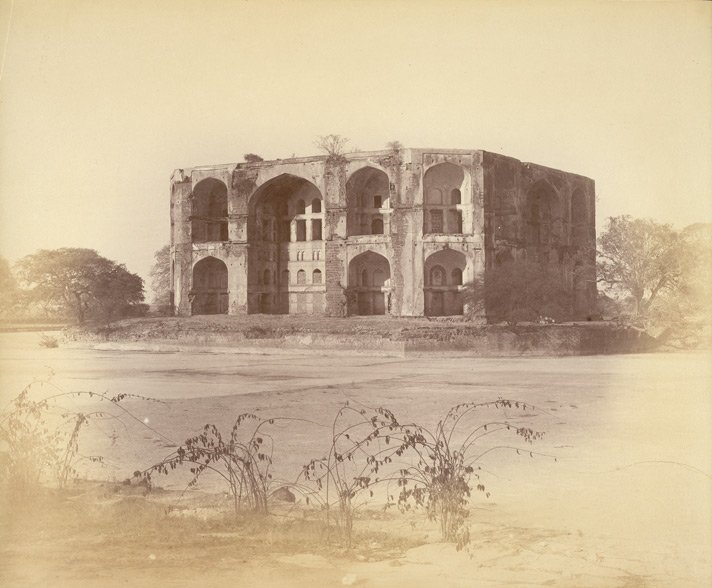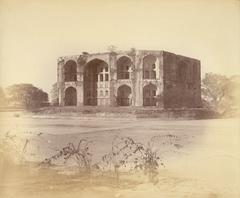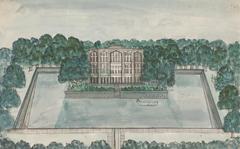
Farah Bagh Visiting Hours, Tickets, and Historical Insights
Date: 24/07/2024
Introduction
Farah Bagh, also known as Faria Bagh, is a historical gem located in Ahmednagar, Maharashtra, India. This architectural marvel, constructed in 1583 by the Nizam Shahi rulers, stands as a testament to the rich cultural and architectural heritage of the Deccan region. The palace was overseen by the renowned architect Salabat Khan II and served as a royal retreat for Sultan Murtaza Nizam Shah I. Farah Bagh is particularly noted for its unique octagonal design and advanced construction techniques for its time, including a natural cooling system that kept the interiors significantly cooler than the outside environment (Navrang India). Despite its current state of disrepair, the palace remains a significant site for historians, architects, and tourists eager to explore its historical and architectural significance.
The palace was not just a residence but a cultural hub where music and games were integral to the royal lifestyle. Sultan Murtaza Nizam Shah I often retired to Farah Bagh to engage in leisure activities, further highlighting its importance as a place of relaxation and cultural exchange (Wikipedia). Over the centuries, however, Farah Bagh has suffered from neglect and lack of maintenance, leading to its current dilapidated state. The once-grand palace and its surrounding structures have fallen into disrepair, and the pond that once surrounded the palace has dried up (Navrang India).
Farah Bagh’s construction during a period of significant political and cultural activity in the Deccan region adds to its historical importance. The Nizam Shahi dynasty, which ruled Ahmednagar, was one of the five Deccan Sultanates that emerged after the decline of the Bahmani Sultanate. The construction of Farah Bagh and other architectural marvels in Ahmednagar reflects the dynasty’s ambition to establish a strong cultural and political presence in the region (Wikipedia).
Table of Contents
- Farah Bagh - A Historical Treasure in Ahmednagar
Farah Bagh - A Historical Treasure in Ahmednagar
Farah Bagh, a historic palace in Ahmednagar, Maharashtra, offers a fascinating glimpse into the architectural and cultural achievements of the Nizam Shahi dynasty. This article explores its history, significance, visitor information, and more.
Historical Background
Origins and Construction
Farah Bagh, also known as Faria Bagh, is a historic palace situated in Ahmednagar, Maharashtra, India. The palace was constructed by the Nizam Shahi rulers and completed in 1583. The construction of Farah Bagh was overseen by the renowned architect Salabat Khan II, who played a pivotal role in its design and completion (Navrang India). The palace was part of a larger palatial complex that served as a retreat for the royal family, particularly for Sultan Murtaza Nizam Shah I.
Architectural Significance
The architectural design of Farah Bagh is noteworthy for its octagonal shape and the use of advanced construction techniques for its time. The palace was surrounded by a 500-yard garden, which included various trees and water features that contributed to its serene atmosphere. The central structure of the palace, now in ruins, was originally surrounded by a pond that was 17 feet deep and 150 feet wide (Navrang India). This pond, along with the garden, played a crucial role in the palace’s natural cooling system, which kept the interiors significantly cooler than the outside temperature.
Royal Retreat and Cultural Hub
Farah Bagh was not just a residence but also a cultural hub for the Nizam Shahi rulers. Sultan Murtaza Nizam Shah I often retired to Farah Bagh to play chess with a Delhi singer named Fateh Shah, for whom he built a separate mahal called Lakad Mahal within the garden (Wikipedia). This highlights the palace’s role as a place of leisure and cultural exchange, where music and games were integral to the royal lifestyle.
Decline and Neglect
Over the centuries, Farah Bagh has suffered from neglect and lack of maintenance. The once-grand palace and its surrounding structures have fallen into a state of disrepair. The pond that once surrounded the palace has dried up, and the central structure is now in ruins. Despite its historical significance, the site has not received the attention it deserves from heritage conservation authorities (Navrang India).
Historical Context
Farah Bagh was constructed during a period of significant political and cultural activity in the Deccan region. The Nizam Shahi dynasty, which ruled Ahmednagar, was one of the five Deccan Sultanates that emerged after the decline of the Bahmani Sultanate. The construction of Farah Bagh and other architectural marvels in Ahmednagar, such as the Ahmednagar Fort and the Hasht Bihisht Bagh, reflect the dynasty’s ambition to establish a strong cultural and political presence in the region (Wikipedia).
Architectural Features
The palace’s architecture is a blend of Persian and Indian styles, characterized by high ceilings, domed roofs, and intricate stucco work. The octagonal design of the central palace, with its four large arches and several smaller ones, is a testament to the architectural ingenuity of the time. The use of lime plaster embedded with stone, fired pottery, and brick pieces in the construction helped improve the building’s permeability and durability (Hindustan Times).
Natural Cooling System
One of the most remarkable features of Farah Bagh is its natural cooling system. The palace was designed to remain cool even during the scorching summer months, with temperatures inside the building staying 8-12 degrees Celsius lower than the outside temperature, which could reach up to 48 degrees Celsius. This was achieved through the use of a 13-cm-thick lime plaster embedded with materials that increased its porosity and moisture absorption capacity. The surrounding water features and gardens also played a crucial role in maintaining a cool environment inside the palace (Navrang India).
Visitor Information
Ticket Prices and Opening Hours
Visiting Farah Bagh offers a unique glimpse into history. The palace is open to the public daily from 8:00 AM to 6:00 PM. Tickets are priced at INR 50 for adults and INR 25 for children. Guided tours are available for an additional fee, providing more in-depth knowledge about the palace’s history and architecture.
Travel Tips
- Best Time to Visit: The best time to visit Farah Bagh is during the cooler months from October to March.
- Accessibility: The site is partially accessible to visitors with disabilities, though some areas may be challenging to navigate.
- Nearby Attractions: While in Ahmednagar, consider visiting other historical sites such as the Ahmednagar Fort and the Hasht Bihisht Bagh.
Cultural and Historical Legacy
Farah Bagh holds a significant place in the cultural and historical landscape of Ahmednagar. It serves as a reminder of the opulence and architectural prowess of the Nizam Shahi dynasty. Despite its current state of disrepair, the palace continues to attract historians, architects, and tourists who are fascinated by its historical and architectural significance. Efforts to restore and preserve Farah Bagh could not only save a valuable piece of history but also provide insights into the advanced construction techniques and cultural practices of the 16th century (Travel and Leisure Asia).
Current State and Conservation Efforts
Today, Farah Bagh stands as a testament to the grandeur of a bygone era, albeit in a dilapidated state. The Archaeological Survey of India (ASI) and other heritage conservation bodies have been criticized for their lack of action in preserving this historical monument. There is a growing call for urgent conservation measures to restore Farah Bagh to its former glory and to protect it from further deterioration (Navrang India).
Frequently Asked Questions
What are the visiting hours for Farah Bagh?
Farah Bagh is open daily from 8:00 AM to 6:00 PM.
How much are tickets to Farah Bagh?
Tickets are priced at INR 50 for adults and INR 25 for children.
What is the best time to visit Farah Bagh?
The best time to visit is during the cooler months from October to March.
Conclusion
In summary, Farah Bagh is a significant historical and architectural landmark that offers a glimpse into the rich cultural heritage of the Nizam Shahi dynasty. Its unique architectural features, natural cooling system, and historical context make it a valuable site for both historical research and tourism. Despite its current state of neglect, Farah Bagh continues to attract historians, architects, and tourists who are fascinated by its historical and architectural significance. Efforts to restore and preserve Farah Bagh could not only save a valuable piece of history but also provide insights into the advanced construction techniques and cultural practices of the 16th century (Travel and Leisure Asia).
Today, Farah Bagh stands as a testament to the grandeur of a bygone era, albeit in a dilapidated state. It is imperative that the Archaeological Survey of India (ASI) and other heritage conservation bodies take urgent measures to restore Farah Bagh to its former glory and protect it from further deterioration. Visiting Farah Bagh offers a unique opportunity to delve into the history and culture of the Nizam Shahi period, making it a worthwhile destination for history enthusiasts and architecture aficionados alike (Navrang India). For more historical insights and travel tips, consider downloading the Audiala app or following related social media updates.


